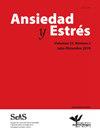Uso de la Teleterapia para el Tratamiento de los Trastornos de Ansiedad, TOC y TEPT, Durante la Pandemia por COVID-19 en España
IF 0.5
Q4 PSYCHOLOGY, CLINICAL
R. Gordillo, P. González, Victoria del Barrio, Rodolfo Ramos
{"title":"Uso de la Teleterapia para el Tratamiento de los Trastornos de Ansiedad, TOC y TEPT, Durante la Pandemia por COVID-19 en España","authors":"R. Gordillo, P. González, Victoria del Barrio, Rodolfo Ramos","doi":"10.5093/anyes2022a12","DOIUrl":null,"url":null,"abstract":"The distribution of teletreatment carried out by psychologists during the COVID-19 pandemic for GAD, specific phobia, agoraphobia, social anxiety, panic, OCD and PTSD, and whether experience in teletherapy has an significant effect on demand have not been studied. The results indicate that GAD with 69.2% has been the disorder that has received the most teletherapy and phobia with 60.5%, the least. Panic, social anxiety, PTSD, OCD, and agoraphobia had a demand of 67.2%, 66.8%, 64.0%, 63.5%, and 62.2%, respectively. The experience in teletherapy was significant. Tele-treatment for experienced psychologists increased an average of 93.9% compared to 35.7% for those without experience. 22.8% of psychologists did not carry out anxiety teletherapy. These results may be useful to develop specific prevention and telematic intervention programs for anxiety disorders in the face of future coronavirus pandemics. © 2022. Sociedad Española para el Estudio de la Ansiedad y el Estrés - SEAS. Colegio de la Psicología de Madrid. Todos los derechos reservados. All Rights Reserved.","PeriodicalId":45616,"journal":{"name":"Ansiedad y Estres-Anxiety and Stress","volume":"1 1","pages":""},"PeriodicalIF":0.5000,"publicationDate":"2022-01-01","publicationTypes":"Journal Article","fieldsOfStudy":null,"isOpenAccess":false,"openAccessPdf":"","citationCount":"0","resultStr":null,"platform":"Semanticscholar","paperid":null,"PeriodicalName":"Ansiedad y Estres-Anxiety and Stress","FirstCategoryId":"1085","ListUrlMain":"https://doi.org/10.5093/anyes2022a12","RegionNum":0,"RegionCategory":null,"ArticlePicture":[],"TitleCN":null,"AbstractTextCN":null,"PMCID":null,"EPubDate":"","PubModel":"","JCR":"Q4","JCRName":"PSYCHOLOGY, CLINICAL","Score":null,"Total":0}
引用次数: 0
Abstract
The distribution of teletreatment carried out by psychologists during the COVID-19 pandemic for GAD, specific phobia, agoraphobia, social anxiety, panic, OCD and PTSD, and whether experience in teletherapy has an significant effect on demand have not been studied. The results indicate that GAD with 69.2% has been the disorder that has received the most teletherapy and phobia with 60.5%, the least. Panic, social anxiety, PTSD, OCD, and agoraphobia had a demand of 67.2%, 66.8%, 64.0%, 63.5%, and 62.2%, respectively. The experience in teletherapy was significant. Tele-treatment for experienced psychologists increased an average of 93.9% compared to 35.7% for those without experience. 22.8% of psychologists did not carry out anxiety teletherapy. These results may be useful to develop specific prevention and telematic intervention programs for anxiety disorders in the face of future coronavirus pandemics. © 2022. Sociedad Española para el Estudio de la Ansiedad y el Estrés - SEAS. Colegio de la Psicología de Madrid. Todos los derechos reservados. All Rights Reserved.
在西班牙COVID-19大流行期间,使用远程疗法治疗焦虑症、强迫症和创伤后应激障碍
本文章由计算机程序翻译,如有差异,请以英文原文为准。

 求助内容:
求助内容: 应助结果提醒方式:
应助结果提醒方式:


